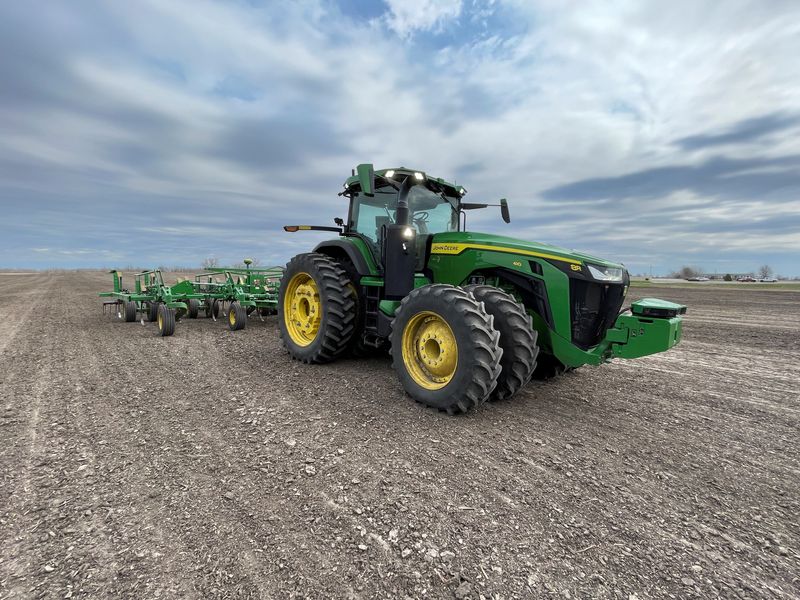By Bianca Flowers and Joseph White
BONDURANT, Iowa (Reuters) -Deere & Co has sold its tractors and other equipment to farmers for decades, but the world's largest agriculture machinery manufacturer is tearing a page from the technology world's playbook - combining cutting-edge hardware with software and subscription models to drive revenue growth.
In a world with a dwindling number of grain producers and a growing population, Deere (NYSE:DE) and its rivals are developing self-driving equipment loaded with the latest software that is harvesting a new kind of bumper crop: data. All that translates into recurring revenue, something companies like Apple (NASDAQ:AAPL) have long enjoyed and industrial manufacturers like Deere hungrily eye. "The more technology we can develop to allow farmers to get productivity out of their land without having to spend so much money on fertilizer and inputs, the better off everybody is," Julian Sanchez, Deere's director of emerging technology, told Reuters.
Investments in automation for high-horsepower equipment is only at its inception for Deere and rivals AGCO and CNH Industrial (NYSE:CNHI). The next step is to equip machines to plant seeds using satellite imagery and soil data, Sanchez said.
While Deere has not outlined what that could mean to its bottom line, last fall U.S. automaker General Motors Co (NYSE:GM) said it was targeting up to $25 billion in software-driven services by 2030, and added its Cruise self-driving unit could achieve $50 billion in annual revenue within six years. The race among farm equipment companies to automate agriculture has accelerated amid a burgeoning food crisis. And Deere's strategy around scaling its suite of tech products is now in the spotlight, after the manufacturer's stock plunged 14% on May 20 following a quarterly revenue miss. It was the biggest drop for Deere in 14 years. The timing comes as the war in Ukraine and widespread drought in key grain-producing countries have roiled commodity markets, causing grain and farm input prices to spike as supplies shrink. That, in turn, has U.S. farmers scrambling to boost crop yields, yet limit their fertilizer and pesticide use.
That and a shrinking farm labor workforce has opened the door for Deere and others to make their high-tech push. For farmers, the prize is higher crop yields. For Illinois-based Deere, it's the revenue.
Autonomous machinery is where Deere is placing its bet as artificial intelligence becomes more integrated in farming. Its self-driving 8R tillage tractor will be the latest addition to the company's algorithm-enabled offerings when the green machines go on sale in the fall.
The new tractor will be priced at $500,000. However, the autonomy feature will be sold separately. Deere executives told analysts at a conference that the company will largely maintain its "point-of-sale" model for equipment, but will integrate a software-as-a-service (SaaS) model for its autonomous solutions. That will likely include their self-driving tractor.

"While it may take us a few years to build out a base of recurring revenues, autonomous solutions, on top of our underlying machine forms, will be recurring," said Joshua Jepsen, Deere's deputy financial officer. The recurring revenue model can be economically favorable to heavy machinery manufacturers "based on those data insights," said Michael Staebe, a Bain & Company partner focused on machinery. In Deere’s case, using a subscription model by either selling or leasing its driverless tractor can result in higher margins. "After expenses, every incremental dollar falls straight to the bottom line," Edward Jones analyst Matt Arnold said. "We would expect it to be an attractive offering to farmers given the efficiency it offers them, and lucrative to Deere."
AGRONOMIC DATA HELPS BOTTOM LINE Farmers have long been wary about how machinery and supplier firms profit off the data gleaned from their operations, and how secure such data is. But with farmers facing economic pressures, Deere and other manufacturers said it is easier to sell farmers on making such investments. One key reason: The ability to glean crop insights from huge amounts of agronomic data takes the guesswork out of when to plant and how many seeds to use - which saves farmers money. "Everybody in the industry is much more data-focused than we have ever seen them," said Michael Boehlje, a professor at Purdue University. "(Companies) can do profit projections by geographic space in fields. That takes you to a different level of thinking and analysis.” In 2020, Deere acquired Harvest Profit, a farm profitability software company that has been integrated into the John Deere Operations Center. The platform stores and lets farmers access their machine data from the cloud. "When I look at what precision ag has done for our operations and what we can accomplish in a day's time compared to 10 to 20 years ago, it's so much easier," said Jeremy Jack, a row crop farmer in Mississippi and chief executive of Silent Shade Planting Co. Ron Heck's fleet of Case IH combines and tractors are equipped with automated steering to harvest his 4,000 acres where he rotates soybeans and corn. The fourth-generation farmer in Iowa said some of his new equipment is loaded with technology. "Unfortunately for us it costs more, but hopefully the costs will be paid back in the long run by better efficiency."